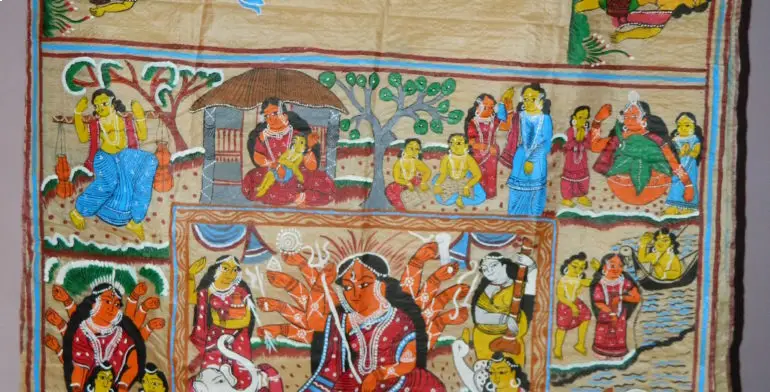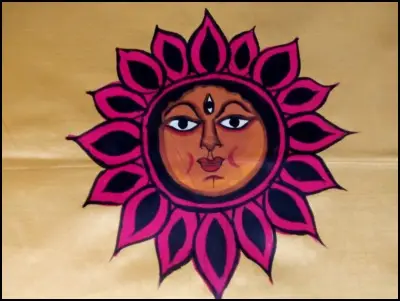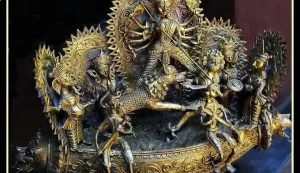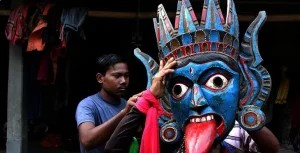
Pattachitra style painiting , which blends oral storytelling with visual imagery.The word pata is derived from the Sanskrit and Pali word meaning “cloth,” and chitra means “picture.” Patachitra means “picture painted on cloth,” and it refers to a storytelling tradition originating in the Medinipur region of West Bengal. The painter community is called Patua, and all of the artists bear the same last name Chitrakar, meaning “painter.” Through this unique art form, the bard presents the story with pictures while simultaneously narrating a song called “Pater Gaan.” Patuas use colors extracted from various trees, leaves, fruits, flowers, seeds, and clay.
Traditionally, their themes revolved around mythological stories, but the newer generations of Patuas paint about contemporary social issues ranging from violence against women to climate change. They are deftly capturing the changing times.
Patachitra artists once had a unique style of presenting their craft: they would go to different villages, singing and telling the stories within the paintings with song and ethos to these themes. Interestingly, despite the fact they all belonged to the Muslim community and practiced Islam faith, they all painted about Hindu gods and goddesses and sang songs in their praise. They did not see their religious beliefs as a barrier to their craft.

Revival & Sustainability :
Pattachitra was a dying art by the early 50s of the last century in Bengal,India .The kings no more patronized the artists and the public did not buy the paintings any longer. It was an American lady called Halina Zealy who resuscitated and revived the art .Today village Naya Gram,Pingla of Mediniore has become a model art village. This village has traditionally been entrusted to male patta paintings of Lord Krishna, Goddess Durga and birds and Animals to complement the “pater Gaan’ or the song narrating the mythological Story of Gods and Goddess.
The chitrakars also paint the temple walls, the temple walls, the chariots and in their free time paint scrolls and sells to the public. The paintings they do are famous as ‘pattachitra’.
Pattachitras of Bengal are unique and known for their exquisite artistry. These are different from the patuas of Orissa;miniature paintings o f Rajasthan, folk paintings of Madhubani and the narrative paintings of Kalamkari.
The paintings of Bengal are still linked to the Gods and Goddess from temples and have ritual significance
The Story of communal harmony.
These paintings are based on Hindu mythology and specially inspired by Krishna,Radha and Vaishnava cult.All colours used in the Paintings are natural and paintings are made fully old traditional way by Chitrakaras . Pattachitra style of painting is one of the oldest and most popular art forms of Bengal and Odisha. The name Pattachitra has evolved from the Sanskrit words patta, meaning canvas, and chitra, meaning picture.
Pattachitra is thus a painting done on canvas, and is manifested by rich colourful application, creative motifs and designs, and portrayal of simple themes, mostly hindu mythological in depiction.The traditions of pattachitra paintings are more than thousand years old.
A special feature of Bengal’s Patachitra is that the stories are essentially from Hindu mythology but the artists are overwhelmingly Muslim. This is a classic case of communal harmony practised down the generations in West Bengal.


Though Naya Gram Village on the bank of river Rupnarayan about 112 kilometers from Kolkata is considered Bengla’s art land and Nandakumar are also art village that produce numerous pata painting for commercial purpose.
The chitrakars take their art with seriousness and they maintain strict regimen in their life style. Earlier, it was only the male chitrakaras who used to paint .But today, others have also adopted the art and womenfolk have carved a niche for themselves.



